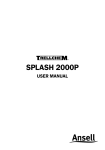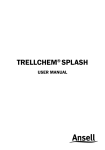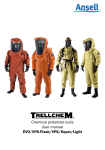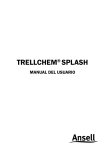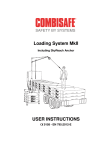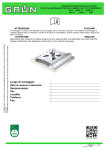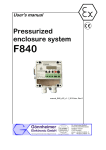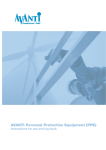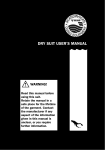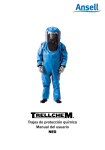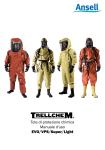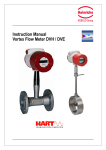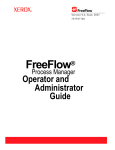Download FREEFLOW HOOD & MASK HOOD - Ansell Protective Solutions
Transcript
FREEFLOW HOOD & MASK HOOD USER MANUAL IMPORTANT! This manual is valid only for Trellchem® Freeflow Hood and Trellchem® Mask Hood. See chapter ”Freeflow Hood” or ”Mask Hood” for information on respective hood. The hood may only be used by trained personnel that is familiar with the contents of this manual. A risk analysis must be performed to determine the protection level and type of protective clothing required before any work involving chemicals is performed. Failure to comply with any of the recommendations given herein may result in serious injury or death. Please check http://protective.ansell.com to make sure you have the latest edition of this manual. 3 TABLE OF CONTENTS — FREEFLOW HOOD — IMPORTANT!................................................................................ 3 General........................................................................................ 6 Scope.............................................................................................. 6 Use.................................................................................................. 6 EC type approval............................................................................. 6 Marking....................................................................................... 7 Symbols/Pictograms on label........................................................ 7 Size.................................................................................................. 9 Marking of components................................................................. 9 Hood material and components................................................ 9 Antifog agents................................................................................. 9 Air distribution system.............................................................10 Description...................................................................................10 Technical information...................................................................11 Requirements - Air supply............................................................11 Safety considerations..............................................................11 Donning.....................................................................................13 Doffing.......................................................................................15 Storage instructions.................................................................15 Inspection.................................................................................16 Test of air distribution system (flow check)............................ 17 Equipment.....................................................................................17 Procedure.....................................................................................17 Repair and maintenance..........................................................19 Repair of hood - general...............................................................19 Repair of punctures and minor damages - hood material.........19 Repair of air distribution system..................................................20 Maintenance instructions - Air distribution system....................20 Maintenance instructions - Overpressure valve.........................20 Spare part list...............................................................................21 Cleaning instructions...............................................................21 Decontamination guidelines....................................................21 Retirement and disposal..........................................................24 Chemical and technical data...................................................25 EC type approval data - hood material and seams....................25 4 TABLE OF CONTENTS — MASK HOOD — General......................................................................................27 Scope............................................................................................27 Use................................................................................................27 EC type approval...........................................................................27 Marking.....................................................................................28 Symbols/Pictograms on label......................................................28 Size................................................................................................30 Hood material and components..............................................30 Safety considerations..............................................................30 Donning.....................................................................................31 Doffing.......................................................................................31 Storage instructions.................................................................32 Inspection.................................................................................33 Repair and maintenance..........................................................33 Repair of hood - general...............................................................33 Repair of punctures and minor damages - hood material.........34 Cleaning instructions - hood material....................................35 Decontamination guidelines - hood material.........................35 Retirement and disposal..........................................................38 Chemical and technical data...................................................39 EC type approval data - hood material and seams....................39 5 FREEFLOW HOOD General Scope This chapter of the manual is valid only for Trellchem® Freeflow Hood. Use The Trellchem® Freeflow Hood is intended for respiratory protection and type 3/”liquid tight” partial body chemical protective clothing. The hood is of reusable type. When used correctly the hood provides respiratory protection to class 4A of EN 14594:2005 and partial body chemical protection according to type PB [3] of EN 14605:2005. IMPORTANT: See ”Safety considerations” for safety considerations and limitations of use. EC type approval EC type examination has been perfomed by and EC type approval has been issued by DEKRA EXAM Bochum GmbH Dinnendahlstraße 9, 44809 Bochum, Germany, notified body 0158. EC type approval certificate 6745 A/09/34/PSA. The hood is CE marked according to the PPE directive 89/686/ EEC and is approved as a class 4A respiratory protective device according to EN 14594:2005 and type PB [3] partial body reusable chemical protective hood according to EN 14605:2005. The notified body that is responsible for quality control is SP Technical Research Institute of Sweden, notified body number 0402. 6 FREEFLOW HOOD Marking Symbols/Pictograms on label This marking (CE-marking) indicates that the hood has EC type approval and complies with the Council Directive on Personal Protective Equipment 89/686/EEC. 0402 is the number of the notified body that is responsible for quality control, see above. This pictogram indicates that the hood offers chemical protection. This pictogram indicates that this manual has to be read. This pictogram indicates the storage temperature range for the hood, see below. 7 FREEFLOW HOOD This pictogram indicates the size of the hood, see below. This pictogram indicates that the hood is only to be hand washed (max. 40 °C/104 °F). This pictogam indicates that the hood shall not be tumbled dry. This pictogram indicates that the hood shall not be dry-cleaned. 8 FREEFLOW HOOD Size The Freeflow hood comes in a unisize version, specially designed to fit ontop of workwear etc. of various sizes. The size of the hood is indicated in a pictogram as above. The figures in the pictogram indicate the height and the chest/bust girth of the user in centimetres. Available size range: Size range Unisize Height 160-217 Chest/bust girth (cm) 88-154 Marking of components The manufacturing date indicated on the label on the inside of the hood may be used and applied to the hood as whole, including its attached components. With the exception of the regulator valve, individual components have no marking/label. See ”Recommended shelf life” for shelf life of the hood. See ”Repair and maintenance” for service/replacement intervals for components. Hood material and components The material of the Trellchem® Freeflow Hood is an orange PVC coated fabric (Trellchem® Light material). Alternatively the hood is available in a fabric coated with yellow Viton®/butyl rubber on the outside and orange butyl rubber on the inside (Trellchem® Super material). (Viton® is a registered trademark of DuPont.) The hood is fitted with 1 mm PVC visor. Antifog agents Antifog gel, art no 069 000 710, that temporarily prevents the visor from fogging up is available and should be used on the visor. Alternatively an antifog lens may be fitted to the inside of the visor. 9 FREEFLOW HOOD Air distribution system Description The Trellchem® Freeflow Hood air distribution system consists of: • A valve with an airline passthrough • Internal tubing with silencer • A warning whistle • An external hose fitted with a CEJN 341 (”Euro”) coupling for connection to an external air source. When in use the system shall be connected to an air source with 5-8 bars, which gives an airflow of 350-365 l/min in the hood. The whistle will sound if the pressure goes below 4.6 bars and there is a risk that the minimum flow is not fulfilled. The Trellchem® Freeflow Hood is a class 4A device according to EN 14594 for which the maximum allowable length of air supply hose is 10 meters. Check the function of the whistle by connecting the source of air via a pressure reducer and reducing the pressure. Make sure that the minimum flow through the hood is attained by connecting a flow meter (art no 487 090 050) to the silencer. See ”Test of air distribution system” below for use of the flow meter. NOTE: The Trellchem® Freeflow Hood is designed for use without helmet or with an industrial helmet of type MSA Super V-Gard (the helmet itself is not part of the EC type approval). The hood itself does not provide protection from impact. If a helmet is used, it should have a chin strap to prevent it from falling off during work. WARNING: If a helmet is used, make sure the helmet peak is not in direct contact with the hood visor during work. This may obstruct the airflow and cause an increase in the carbon dioxide level in the breathing zone. 10 FREEFLOW HOOD Technical information • Working pressure: 5-8 bars, warning whistle sounds below 4.6 bars • Min. flow rate: 350 litres/min • Max. flow rate: 365 litres/min • Noise level: <80 dB(A) • Inward leakage class 4A (< 0.05%) according to EN 14594 Requirements - Air supply The air supply system, mobile or stationary, shall have a working pressure of minimum 5 bars and a maximum of 8 bars. The air supply system must fulfil the applicable requirements of EN 14594. The user must check that the capacity of the air supply system is sufficient for every user connected to it. WARNING: The delivered air must fulfil the requirements for breathing air according to EN 12021 and EN 132. The hood must not be used with oxygen or oxygen enriched air. Precautions must be taken to avoid accidental connection of the hood to a supply of gas other than breathable air. This risk must be part of the risk analysis. Safety considerations All personnel should be well acquainted with this manual before using the hoods. Chemical response Working with chemicals can be a very complex task and may involve chemicals other than those stipulated as test chemicals in standards or in this documentation. Besides the specific chemical(s) encountered other aspects such as the concentration, temperature of the chemical, mixtures of chemicals, flammability, toxicity etc. have to be considered. Identify the chemicals before entering into the hazardous area in the Freeflow Hood. Minimize the exposure to chemicals during the work. Avoid direct contact with the chemicals as far as possible. 11 FREEFLOW HOOD Guidelines for use Choosing the appropriate chemical protective clothing, accessories and other necessary equipment to work with chemicals, has to be made by qualified safety professionals. IMPORTANT: Trellchem® Freeflow Hood is partial body chemical protection. Splashes of chemicals may, depending on the angle, enter underneath the hood material, e.g. on the chest and back. If this is not acceptable, full body chemical protection must be worn. Trellchem® Freeflow Hood is approved class 4A respiratory protective device according to EN 14594:2005. This protection level may not be sufficient for toxic chemicals in high concentrations. Many types of work and work environments require the use of a helmet. The Trellchem® Freeflow Hood can be used with a safety helmet. Make sure that someone is available to assist while donning, decontaminating and doffing. Also make sure the hood is decontaminated and inspected before it is returned into service or storage. If the hood is damaged, take it out of service and repair or replace as required. Make sure that the hood has not passed its recommended storage life and that it is free from damage before it is taken back into service. Temperatures The hood can be used in temperature ranges from -40 °C till +65 °C. Never use the hood near open flames or intense heat. NOTE: The EC type examination and approval as performed by DEKRA EXAM Bochum GmbH covers use down to -30°C. The risk of heat stress must always be taken into account when using personal protective equipment that encloses the wearer, such as the Trellchem® Freeflow Hood. Depending on the type of work and clothing this risk may be considerable even at moderate ambient temperatures. 12 FREEFLOW HOOD Donning Make sure the hood is visually inspected and free from defects before use. It is possible to don the hood alone, but it is recommended to have someone assist you while dressing. 1. Connect the hood to the external source of air. 2. Pull the hood over your head. Fasten and adjust the waist strap around your waist. 13 FREEFLOW HOOD 3. Through the sleeve openings, adjust the neck strap so that the inner collar fits properly around your neck. 4. This is the correct positioning of the regulation valve on the back of the hood. 14 FREEFLOW HOOD Doffing After a response in hazardous environments the hood must be rinsed with water, preferrably containing detergent, before doffing. Take off the hood in reverse order of that described above. Storage instructions Environmental conditions • Dry, humidity 50 ± 30% • Temperature 5-25 °C • Away from direct sunlight • Away from ozone-generating sources, for example electrical engines, fluorescent lamps and air-conditioners Hood storage methods The hood should be stored: • Folded as upon delivery or hanging • In the plastic bag delivered with it or in another tight bag or box • If stored in a soft bag, never store hoods on top of each other, as too much weight or high pressure may damage the visor • If stored in a box, make sure the box is large enough to easily accommodate the hood without pushing, pressing or squeezing it NOTE: When stored the hood should be unfolded and inspected once a year. Storage life/Shelf life Trellchem® Freeflow Hood: 5 years The storage/shelf life applies under optimal storage conditions (see above) and does not form a guarantee. The storage/shelf life may be exceeded or less than the above stated. Therefore the condition of the hood needs to be checked regularly to evaluate whether it is in good condition or not (see below). 15 FREEFLOW HOOD Inspection The hood is to be inspected upon delivery, after each use and after repair or, if not used, annually. The inspection shall consist of the following steps: • Visual inspection of both inside and outside. • Look for surface damages on material, seams, visor and all other components. • Look for changes in the material properties such as brittleness, stiffness, swelling, stickiness or other phenomena, which could be evidence of chemical degradation. • Check the function of the overpressure valves. Make certain that they are firmly mounted and not damaged. • Make sure that the internal tubing is firmly connected to the regulator valve. • Make sure that the internal tubing passes through the loops inside the hood. • Make sure that the regulation valve is attached to the belt. If any defect/malfunction is found, the hood must be taken out of service. Minor repairs may be done according to the instructions below. Any repair or replacement of parts other than those described in ”Repair and maintenance” may only be performed by a certified Trellchem® dealer or by Ansell Protective Solutions AB. 16 FREEFLOW HOOD Test of air distribution system (flow check) Equipment For test of the air distribution system (flow check), a flow meter is to be used. Procedure The flow meter has one socket to hold the diffuser. 1. Insert the diffuser into the socket. 17 FREEFLOW HOOD 2. Connect the hood to the source of air. Set the conditions to the lowest pressure that can be expected during real use. 3. Make sure the flow meter is held or placed in a stable vertical position. Read the flow. Make sure the flow is 350 l/min as a minimum. Consideration should be given to the need for a margin of safety for pressure/flow variations during real use. IMPORTANT! If the minimum flow is not achieved, the hood must not be used. 4. Detach the flow meter. 18 FREEFLOW HOOD Repair and maintenance Repair of hood - general Always use original Trellchem® parts when repairing. WARNING: Measures must be taken to avoid inhalation of the fumes from the solvent and the glue. Make sure that the working area where repairs are to be carried out is properly ventilated. The Trellchem® repair kit can be used for repair of punctures or minor damages. NOTE: After repairs the hood must be left for 24 hours to allow glue to dry. To assure safe working order and to maintain the Ansell warranty, major repairs such as large tears, visor etc., shall be done by a Ansell certified repair centre or by Ansell Protective Solutions AB. Only the repairs described below may be performed by the user. Service and repair training courses are available, please contact your distributor for information. Damages should always be patched on both the inside and the outside. Start with the inside. Select an appropriate patch, one that is large enough to cover the puncture with a margin of at least 15 mm around the damage. In all instances, the area to be repaired must be clean and dry before application of adhesive and patch. Repair of punctures and minor damages - hood material PVC - Trellchem® Light repair kit (art no 487 080 075): 1 tube of PVC glue 1 bottle Trellchem solvent 1-1197, 250 ml for cleaning 1 set Trellchem repair patches 1 brush 19 FREEFLOW HOOD Viton®/Butyl - Trellchem® Super repair kit (art no 487 080 073): 1 can Trellchem adhesive 6-0724, 125 ml 1 bottle Trellchem hardener 1-7869, 8 ml sufficient for 125 ml adhesive 1 bottle Trellchem solvent 1-1197, 250 ml for cleaning 1 set Trellchem repair patches, yellow for outside and orange for inside 2 brushes 1. Trellchem® Super material only: Add the hardener to the glue. Mix thoroughly. This mixture must be used within two hours. 2. Select a patch which is large enough to cover the damage with a margin of at least 15 mm around the damage. Position the patch accordingly and mark the position with a pen. 3. Clean the patch and the hood material with Trellchem solvent 1-1197. 4. Apply a thin layer of the glue to the damaged area and to the patch. Allow to dry 5-10 minutes, until it is tacky. 5. Repeat step 3, applying a second layer of glue. Let dry until tacky. 6. Apply the patch over the damage, starting from one end to avoid wrinkles. 7. Smooth with a hand roller or any other appropriate tool. 8. Repeat this procedure for the outside of the hood. Repair of air distribution system Damaged parts must be replaced. See spare part list below. WARNING: The complete air distribution system must be replaced if damaged. Do not try to repair. Maintenance instructions - Air distribution system The air distribution system should be serviced every 5 years. Maintenance instructions - Overpressure valve The overpressure valve should be replaced every 5 years. 20 FREEFLOW HOOD Spare part list COMPONENT ARTICLE NUMBER Overpressure valve 072 131 200 Regulator valve (complete with breathing hose and silencer) 072 133 005 Cleaning instructions Air distribution components (regulator valve and hose with silencer) shall be removed before cleaning. Handwash. Machine wash is not recommended. Tumble-dry is not allowed (it may damage the hood). Washing temperatures up to 40 °C (104 °F) may be used. Use EW80 and Incidin Rapid for cleaning and disinfection. Care should be taken not to scratch or damage the material. Let the hood airdry or use a fan. Persistent stains of oil or other substances may be washed off with alcohol/ ethanol. If this is not effective a solvent like white spirit may be used carefully. Take care not to use more solvent than necessary. After this the hood should be rinsed with lukewarm water with mild detergent followed by water. It is important to dry the hood both inside and outside. Drying can be made by hand using a cloth or with a fan/hair dryer. Decontamination guidelines No general decontamination procedure exists, the best way to decontaminate must be decided for the specific chemical encountered. This decision may only be taken by people educated for this task and with a good knowledge of chemistry. Ansell Protective Solutions AB may be contacted for advice. As a first rule a pre-decontamination must always be performed before doffing the hood – the safety of the wearer is the most important! This pre-decontamination should include rinsing with large amounts of water, if possible containing a detergent. 21 FREEFLOW HOOD After this initial procedure the real decontamination can take place and since all chemicals can be divided into groups, depending on chemical and/or physical properties, the following three groups are the most relevant when it comes to decontamination: • volatile • water soluble or reacts with water • water insoluble Depending on which group a chemical falls into, the decontamination procedure will be different, see the following descriptions. A special group of chemicals are the chemical warfare agents, for which we recommend a special decontamination procedure, see below. Volatile chemicals Chemicals that have lower boiling temperature than 80 °C are regarded as volatile. These are typically solvents like ethyl acetate, heptane, benzene, chloroform, acetone and many others. To decontaminate a Freeflow Hood which has been in contact with a volatile compound you air the hood outdoors or in a well-ventilated area, if possible at a slightly elevated temperature (30-40 °C). Hang the hood with enough space around it, so that the air can flow freely around the hood. The required time for ventilating the chemicals depends on the temperature and airflow rate around the hood. After having aired the hood check for odour/smell of the chemicals and/or test the air for residual chemicals by using simple gas detecting tubes. Water soluble chemicals Chemicals that have higher solubility than 60 g/l water are regarded as watersoluble. Also, the solubility is dependent on the temperature; an increase in temperature increases the solubility. Examples of water-soluble chemicals are: phenol, ethylene glycol, sodium, all acids and alkali (see further below). 22 FREEFLOW HOOD When decontaminating a Freeflow Hood which has been in contact with a water-soluble compound you rinse the hood thoroughly with water, preferably with some added detergent. To further enhance the solubility you can use warm water (40 °C). Acids and alkali Examples: sulphuric acid, hydrochloric acid, sodium hydroxide, ammonium hydroxide. Since both acids and alkali are soluble in water, a Freeflow Hood which has been in contact with either one of them should be rinsed with water. Residual acid may first be neutralised with a dilute solution of alkali and vice versa for residual alkali. Afterwards, rinse thoroughly with water with some added detergent. The pH should be checked during the decontamination, when the pH is neutral the decontamination is finished. pH can easily be checked with a pH-stick. Water insoluble chemicals Chemicals that are not water-soluble are soluble in some type of solvent, for example alcohol or white spirit. Chemicals that have lower solubility than 60 g/l water are regarded as water insoluble. Examples are: styrene, pyridine, nitrobenzene, diesel and crude oil. If the hood has been in contact with a water insoluble compound you wipe the hood thoroughly with a cloth soaked in alcohol or white spirit (depending on what solvent will solve the chemical). Afterwards, rinse thoroughly with water with some added detergent. There are chemicals that are so sticky it is more or less impossible to get the hood completely clean. If this occurs the hood must be scrapped. NOTE: The decontamination procedures are not part of the EC type testing and approval. 23 FREEFLOW HOOD Retirement and disposal The hood has to be replaced when worn out, damaged beyond repair or after being exposed to undecontaminable chemicals. If changes in the material properties (brittleness, stiffness, swelling, stickiness or other phenomena) are found, the hood should be taken out of service immediately and replaced. In doubtful cases contact your supplier or Ansell Protective Solutions AB. Worn out hoods should be disposed of according to local regulations for plastic waste. Incineration is recommended. Hoods that are not completely decontaminated must be disposed of in a safe manner, taking local regulations for the specific chemical into account. 24 FREEFLOW HOOD Chemical and technical data EC type approval data - hood material and seams A summary of type approval data according to EN 14605 and EN 14325 (if not otherwise specified) is given below. See ”Air distribution system” for technical data on the air distribution system. PROPERTY HOOD MATERIAL - PERFORMANCE CLASS Light Super Abrasion resistance 6 6 Flex cracking resistance 6 6 Flex cracking at -30°C 6 6 Tear resistance 4 3 Tensile strength 6 6 Puncture resistance 4 3 Resistance to flame 3 3 Seam strength 6 6 25 FREEFLOW HOOD CHEMICAL RESISTANCE TO PERMEATION - PERFORMANCE CLASS Light hood material Light seam Super hood material Super seam Light/Super visor Acetone - - 6 5 - Acetonitrile - - 6 6 - Ammonia (g) - - 6 6 - Carbon disulphide - - 6 6 - Chlorine (g) - - 6 6 - Dichlorometane - - 3 3 - Diethyl amine - - 2 2 - Ethyl acetate - - 3 3 - Heptane - - 6 6 - Hydrogen chloride (g) - - 6 6 - Methanol - - 6 6 - Sodium hydroxide, 40% 6 6 6 6 6 Sulphuric acid, 96% 4 3 6 6 4 Tetrahydrofuran - - 1 1 - Toluene - - 6 6 - Permeation data based on EN 14325. Note 1: Permeation data applies to the hood material only, not the visor. Note 2: The Trellchem® Light material is not suitable for continuous exposure to solvents. 26 MASK HOOD General Scope This chapter of the manual is valid only for Trellchem® Mask Hood. A separate manual for the mask is included with the hood. Use The Trellchem® Mask Hood is intended for respiratory protection as provided by the face mask and type 3/”liquid tight” partial body chemical protective clothing. For details of the respiratory protection see the approvals and user instructions for the face mask. The hood is of reusable type and made from either the Trellchem® Super material or the Trellchem® Light material. The hood provides partial body chemical protection according to type PB [3] of EN 14605:2005. When used alone (without additional chemical protective clothing) the hood provides protection from liquid splashes to the head. It will also provide protection from direct splashes coming straight onto the chest or back area but not from splashes from the side or from underneath the user. If full body protection is required the hood may be used together with Trellchem Splash 600 with collar (without hood). See the manual for the face mask for further information pertaining to the mask. IMPORTANT: See ”Safety considerations” for safety considerations and limitations of use. EC type approval EC type examination has been performed by FORCE Certification A/S, Park Allé 345, DK-2605 Bröndby, Denmark, notified body 0200. EC type approval certificate DK-0200-PPE-1917 version 3. The hood is CE marked according to the PPE directive 89/686/EEC and is approved as type PB [3] partial body reusable chemical protective hood according to EN 14605:2005. See also ”Use” above. 27 MASK HOOD The notified body that is responsible for quality control according to article 11B of the PPE directive 89/686/EEC is SP Technical Research Institute of Sweden, notified body number 0402. For the approval of the face mask, see the separate approval and documentation from the manufacturer. Marking Symbols/Pictograms on label This marking (CE-marking) indicates that the hood has EC type approval and complies with the Council Directive on Personal Protective Equipment 89/686/EEC. 0402 is the number of the notified body that is responsible for quality control, see above. This pictogram indicates that the hood offers chemical protection. This pictogram indicates that this manual has to be read. 28 MASK HOOD This pictogram indicates the size of the hood, see below. This pictogram indicates that the hood is only to be hand washed (max. 40 °C/104 °F). This pictogam indicates that the hood shall not be tumbled dry. 29 MASK HOOD Size The Mask Hood comes in a unisize version, specially designed to fit ontop of workwear etc. of various sizes. The size of the hood is indicated in a pictogram as above. The figures in the pictogram indicate the height and the chest/bust girth of the user in centimetres. Available size range: Size range Unisize Height 160-217 Chest/bust girth (cm) 88-154 Hood material and components The material of the Trellchem® Mask Hood is an orange PVC coated fabric (Trellchem® Light material). Alternatively the hood is available in a fabric coated with yellow Viton®/butyl rubber on the outside and orange butyl rubber on the inside (Trellchem® Super material). (Viton® is a registered trademark of DuPont.) Safety considerations All personnel should be well acquainted with this manual and the manual for the face mask before using the hoods. Chemical response Working with chemicals can be a very complex task. Besides the specific chemical(s) encountered other aspects such as the concentration, temperature of the chemical, mixtures of chemicals, flammability, toxicity etc. have to be considered. Identify the chemicals before entering into the hazardous area. Minimize the exposure to chemicals during the work. Avoid direct contact with the chemicals as far as possible. All information on chemical resistance etc. in this manual is only applicable to the hood, not the face mask. See the separate face mask manual or contact the manufacturer for further information on the face mask. 30 MASK HOOD Guidelines for use Choosing the appropriate chemical protective clothing, accessories and other necessary equipment to work with chemicals, has to be made by qualified safety professionals. IMPORTANT: Trellchem® Mask Hood is partial body chemical protection. Splashes of chemicals may, depending on the angle, enter underneath the hood material, e.g. on the chest and back. If this is not acceptable, full body chemical protection must be worn. Make sure that someone is available to assist while donning, decontaminating and doffing. Also make sure the hood is decontaminated and inspected before it is returned into service or storage. If the hood is damaged, take it out of service and repair or replace as required. See separate instructions for the face mask. Donning 1) Turn the hood inside out. 2) Put on the mask according to the instructions in the manual for the mask. 3) Pull the hood over your head and tighten the straps on the front. Doffing Take off the hood in reverse order of that described above. 31 MASK HOOD Storage instructions Environmental conditions • Dry, humidity 50 ± 30% • Dust free • Temperature 5-25 °C • Away from direct sunlight • Away from ozone-generating sources, for example electrical engines, fluorescent lamps and air-conditioners Hood storage methods The hood should be stored: • Folded as upon delivery or hanging • In the plastic bag delivered with it or in another tight bag or box • If stored in a soft bag, never store hoods on top of each other, as too much weight or high pressure may deform the mask • If stored in a box, make sure the box is large enough to easily accommodate the hood without pushing, pressing or squeezing it NOTE: When stored the hood should be unfolded and inspected once a year. Storage life/Shelf life Trellchem® Mask Hood: 10 years for the hood material. For storage/shelf life of the mask, see the mask manual. The storage/shelf life applies under optimal storage conditions (see above) and does not form a guarantee. The storage/shelf life may be exceeded or less than the above stated. Therefore the condition of the hood needs to be checked regularly to evaluate whether it is in good condition or not (see below). 32 MASK HOOD Inspection The hood is to be inspected upon delivery, after each use and after repair or, if not used, annually. The inspection shall consist of the following steps: • Visual inspection of both inside and outside. • Look for surface damages on material and seams. • Look for changes in the material properties such as brittleness, stiffness, swelling, stickiness or other phenomena, which could be evidence of chemical degradation. If any defect/malfunction is found, the hood must be taken out of service. Minor repairs may be done according to the instructions below. Any repair or replacement of parts other than those described in ”Repair and maintenance” may only be performed by a certified Trellchem® dealer or by Ansell Protective Solutions AB. For inspection of the mask, see the mask manual. Repair and maintenance Repair of hood - general Always use original Trellchem® parts when repairing. WARNING: Measures must be taken to avoid inhalation of the fumes from the solvent and the glue. Make sure that the working area where repairs are to be carried out is properly ventilated. The Trellchem® repair kit can be used for repair of punctures or minor damages. NOTE: fter repairs the hood must be left for 24 hours to allow glue to dry. To assure safe working order and to maintain the Ansell warranty, major repairs such as large tears, visor etc., shall be done by a Ansell certified repair centre or by Ansell Protective Solutions AB. Only the repairs described below may be performed by the user. Service and repair training courses are available, please contact your distributor for information. 33 MASK HOOD Damages should always be patched on both the inside and the outside. Start with the inside. Select an appropriate patch, one that is large enough to cover the puncture with a margin of at least 15 mm around the damage. In all instances, the area to be repaired must be clean and dry before application of adhesive and patch. Repair of punctures and minor damages - hood material Viton®/Butyl - Trellchem® Super repair kit (art no 487 080 073): 1 can Trellchem adhesive 6-0724, 125 ml 1 bottle Trellchem hardener 1-7869, 8 ml sufficient for 125 ml adhesive 1 bottle Trellchem solvent 1-1197, 250 ml for cleaning 1 set Trellchem repair patches, yellow for outside and orange for inside 2 brushes Trellchem® Light repair kit (487 080 075): 1 tube of PVC glue 1 bottle Trellchem solvent 1-1197, 250 ml for cleaning 1 set Trellchem repair patches, bright orange 1 brush 1. Trellchem® Super material only: Add the hardener to the glue. Mix thoroughly. This mixture must be used within two hours. 2. Select a patch which is large enough to cover the damage with a margin of at least 15 mm around the damage. Position the patch accordingly and mark the position with a pen. 3. Clean the patch and the hood material with Trellchem solvent 1-1197. 4. Apply a thin layer of the glue to the damaged area and to the patch. Allow to dry 5-10 minutes, until it is tacky. 5. Repeat step 3, applying a second layer of glue. Let dry until tacky. 6. Apply the patch over the damage, starting from one end to avoid wrinkles. 7. Smooth with a hand roller or any other appropriate tool. 8. Repeat this procedure for the outside of the hood. 34 MASK HOOD Cleaning instructions - hood material Handwash. Machine wash is not recommended. Tumble-dry is not allowed (it may damage the hood). Washing temperatures up to 40 °C (104 °F) may be used. Use EW80 and Incidur for cleaning and disinfection. Care should be taken not to scratch or damage the material. Let the hood airdry or use a fan. Persistent stains of oil or other substances may be washed off with alcohol/ ethanol. If this is not effective a solvent like white spirit may be used carefully. Take care not to use more solvent than necessary. After this the hood should be rinsed with lukewarm water with mild detergent followed by water. It is important to dry the hood both inside and outside. Drying can be made by hand using a cloth or with a fan/hair dryer. For instructions on how to clean the mask, see the mask manual. Decontamination guidelines - hood material IMPORTANT: The following guidelines apply to the hood material. For instructions on how to decontaminate the mask, see the mask manual. No general decontamination procedure exists, the best way to decontaminate must be decided for the specific chemical encountered. This decision may only be taken by people educated for this task and with a good knowledge of chemistry. Ansell Protective Solutions AB may be contacted for advice. As a first rule a pre-decontamination must always be performed before doffing the hood - the safety of the wearer is the most important! This pre-decontamination should include rinsing with large amounts of water, if possible containing a detergent. 35 MASK HOOD After this initial procedure the real decontamination can take place and since all chemicals can be divided into groups, depending on chemical and/or physical properties, the following three groups are the most relevant when it comes to decontamination: • volatile • water soluble or reacts with water • water insoluble Depending on which group a chemical falls into, the decontamination procedure will be different, see the following descriptions. A special group of chemicals are the chemical warfare agents, for which we recommend a special decontamination procedure, see below. Volatile chemicals Chemicals that have lower boiling temperature than 80 °C are regarded as volatile. These are typically solvents like ethyl acetate, heptane, benzene, chloroform, acetone and many others. To decontaminate a Mask Hood which has been in contact with a volatile compound you air the hood outdoors or in a well-ventilated area, if possible at a slightly elevated temperature (30-40 °C). Hang the hood with enough space around it, so that the air can flow freely around the hood. The required time for ventilating the chemicals depends on the temperature and airflow rate around the hood. After having aired the hood check for odour/smell of the chemicals and/or test the air for residual chemicals by using simple gas detecting tubes. Water soluble chemicals Chemicals that have higher solubility than 60 g/l water are regarded as watersoluble. Also, the solubility is dependent on the temperature; an increase in temperature increases the solubility. Examples of water-soluble chemicals are: phenol, ethylene glycol, sodium, all acids and alkali (see further below). 36 MASK HOOD When decontaminating a Mask Hood which has been in contact with a watersoluble compound you rinse the hood thoroughly with water, preferably with some added detergent. To further enhance the solubility you can use warm water (40 °C). Acids and alkali Examples: sulphuric acid, hydrochloric acid, sodium hydroxide, ammonium hydroxide. Since both acids and alkali are soluble in water, a Mask Hood which has been in contact with either one of them should be rinsed with water. Residual acid may first be neutralised with a dilute solution of alkali and vice versa for residual alkali. Afterwards, rinse thoroughly with water with some added detergent. The pH should be checked during the decontamination, when the pH is neutral the decontamination is finished. pH can easily be checked with a pH-stick. Water insoluble chemicals Chemicals that are not water-soluble are soluble in some type of solvent, for example alcohol or white spirit. Chemicals that have lower solubility than 60 g/l water are regarded as water insoluble. Examples are: styrene, pyridine, nitrobenzene, diesel and crude oil. If the hood has been in contact with a water insoluble compound you wipe the hood thoroughly with a cloth soaked in alcohol or white spirit (depending on what solvent will solve the chemical). Afterwards, rinse thoroughly with water with some added detergent. There are chemicals that are so sticky it is more or less impossible to get the hood completely clean. If this occurs the hood must be scrapped. NOTE: The decontamination procedures are not part of the EC type testing and approval. 37 MASK HOOD Retirement and disposal For retirement and disposal of the mask, see the mask manual. The hood has to be replaced when worn out, damaged beyond repair or after being exposed to undecontaminable chemicals. If changes in the material properties (brittleness, stiffness, swelling, stickiness or other phenomena) are found, the hood should be taken out of service immediately and replaced. In doubtful cases contact your supplier or Ansell Protective Solutions AB. Worn out hoods should be disposed of according to local regulations for plastic waste. Incineration is recommended. Hoods that are not completely decontaminated must be disposed of in a safe manner, taking local regulations for the specific chemical into account. 38 MASK HOOD Chemical and technical data EC type approval data - hood material and seams A summary of type approval data according to EN 14605 and EN 14325 (if not otherwise specified) is given below. PROPERTY HOOD MATERIAL - PERFORMANCE CLASS Light Super Abrasion resistance 6 6 Flex cracking resistance 6 6 Flex cracking at -30°C 6 5 Tear resistance 4 4 Tensile strength 6 6 Puncture resistance 4 3 Resistance to flame 3 3 Seam strength 6 6 CHEMICAL RESISTANCE TO PERMEATION - PERFORMANCE CLASS Light hood material Light seam Super hood material Super seam Acetone - - 6 6 Acetonitrile - - 6 6 Ammonia (g) - - 6 6 Carbon disulphide - - 6 6 Chlorine (g) - - 6 6 Dichlorometane - - 2 2 Diethyl amine - - 2 2 Ethyl acetate - - 5 5 Heptane - - 6 6 Hydrogen chloride (g) - - 6 6 Methanol - - 6 6 Sodium hydroxide, 40% 6 6 6 6 Sulphuric acid, 96% 4 3 6 6 Tetrahydrofuran - - 1 1 Toluene - - 3 4 Note 1: Permeation data applies to the hood material only, not the mask. Note 2: The Trellchem® Light material is not suitable for continuous exposure to solvents. 39 © Ansell Protective Solutions AB 1310. Subject to change without notice. Ansell Protective Solutions AB Johan Kocksgatan 10, SE-231 81 Trelleborg, Sweden Tel: +46 (0)10-205 1800, Fax: +46 (0)10-205 1840 http://protective.ansell.com | [email protected]








































